Recycling Plant Investment Memo
VerifiedAdded on 2019/09/30
|6
|1353
|136
Report
AI Summary
This report analyzes a memo to the CEO concerning a proposed investment in a recycling plant. The memo presents two options: investing $21 million in a plant to recycle plastic packaging or outsourcing the recycling. A cost-benefit analysis, including Net Present Value (NPV) calculations, is conducted to evaluate each option. The analysis shows that the self-operating project (option 1) yields a higher NPV than outsourcing (option 2), indicating greater profitability and long-term benefits. The memo also discusses the positive social impact of the investment and the potential for competitive advantages in the global market. However, it acknowledges uncertainties such as tax rates and market share, which could affect the NPV. The report concludes by recommending the self-operating project due to its superior financial performance and positive social implications. The memo includes financial data and references to support its analysis.

Memo
Paraphrase This Document
Need a fresh take? Get an instant paraphrase of this document with our AI Paraphraser
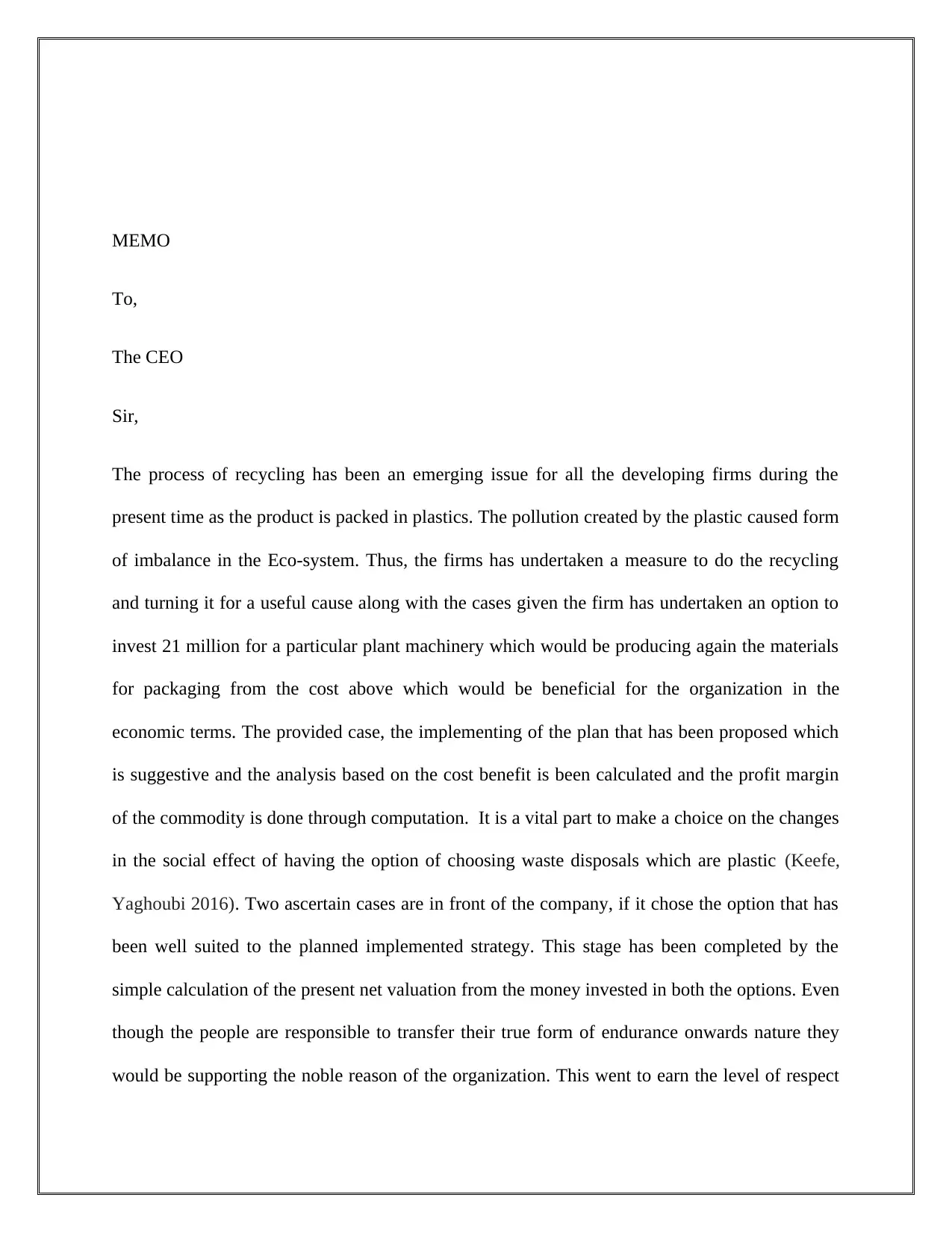
MEMO
To,
The CEO
Sir,
The process of recycling has been an emerging issue for all the developing firms during the
present time as the product is packed in plastics. The pollution created by the plastic caused form
of imbalance in the Eco-system. Thus, the firms has undertaken a measure to do the recycling
and turning it for a useful cause along with the cases given the firm has undertaken an option to
invest 21 million for a particular plant machinery which would be producing again the materials
for packaging from the cost above which would be beneficial for the organization in the
economic terms. The provided case, the implementing of the plan that has been proposed which
is suggestive and the analysis based on the cost benefit is been calculated and the profit margin
of the commodity is done through computation. It is a vital part to make a choice on the changes
in the social effect of having the option of choosing waste disposals which are plastic (Keefe,
Yaghoubi 2016). Two ascertain cases are in front of the company, if it chose the option that has
been well suited to the planned implemented strategy. This stage has been completed by the
simple calculation of the present net valuation from the money invested in both the options. Even
though the people are responsible to transfer their true form of endurance onwards nature they
would be supporting the noble reason of the organization. This went to earn the level of respect
To,
The CEO
Sir,
The process of recycling has been an emerging issue for all the developing firms during the
present time as the product is packed in plastics. The pollution created by the plastic caused form
of imbalance in the Eco-system. Thus, the firms has undertaken a measure to do the recycling
and turning it for a useful cause along with the cases given the firm has undertaken an option to
invest 21 million for a particular plant machinery which would be producing again the materials
for packaging from the cost above which would be beneficial for the organization in the
economic terms. The provided case, the implementing of the plan that has been proposed which
is suggestive and the analysis based on the cost benefit is been calculated and the profit margin
of the commodity is done through computation. It is a vital part to make a choice on the changes
in the social effect of having the option of choosing waste disposals which are plastic (Keefe,
Yaghoubi 2016). Two ascertain cases are in front of the company, if it chose the option that has
been well suited to the planned implemented strategy. This stage has been completed by the
simple calculation of the present net valuation from the money invested in both the options. Even
though the people are responsible to transfer their true form of endurance onwards nature they
would be supporting the noble reason of the organization. This went to earn the level of respect
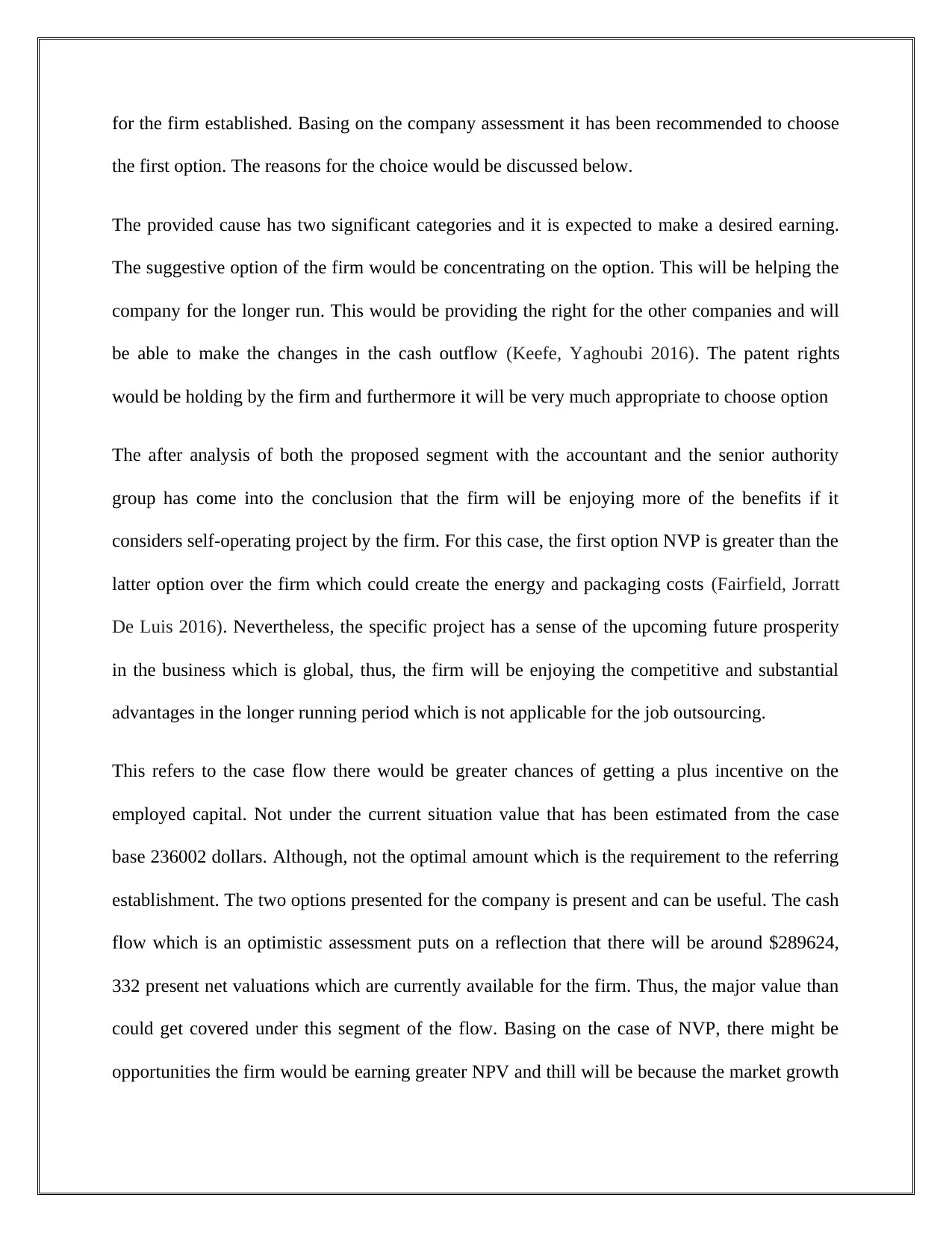
for the firm established. Basing on the company assessment it has been recommended to choose
the first option. The reasons for the choice would be discussed below.
The provided cause has two significant categories and it is expected to make a desired earning.
The suggestive option of the firm would be concentrating on the option. This will be helping the
company for the longer run. This would be providing the right for the other companies and will
be able to make the changes in the cash outflow (Keefe, Yaghoubi 2016). The patent rights
would be holding by the firm and furthermore it will be very much appropriate to choose option
The after analysis of both the proposed segment with the accountant and the senior authority
group has come into the conclusion that the firm will be enjoying more of the benefits if it
considers self-operating project by the firm. For this case, the first option NVP is greater than the
latter option over the firm which could create the energy and packaging costs (Fairfield, Jorratt
De Luis 2016). Nevertheless, the specific project has a sense of the upcoming future prosperity
in the business which is global, thus, the firm will be enjoying the competitive and substantial
advantages in the longer running period which is not applicable for the job outsourcing.
This refers to the case flow there would be greater chances of getting a plus incentive on the
employed capital. Not under the current situation value that has been estimated from the case
base 236002 dollars. Although, not the optimal amount which is the requirement to the referring
establishment. The two options presented for the company is present and can be useful. The cash
flow which is an optimistic assessment puts on a reflection that there will be around $289624,
332 present net valuations which are currently available for the firm. Thus, the major value than
could get covered under this segment of the flow. Basing on the case of NVP, there might be
opportunities the firm would be earning greater NPV and thill will be because the market growth
the first option. The reasons for the choice would be discussed below.
The provided cause has two significant categories and it is expected to make a desired earning.
The suggestive option of the firm would be concentrating on the option. This will be helping the
company for the longer run. This would be providing the right for the other companies and will
be able to make the changes in the cash outflow (Keefe, Yaghoubi 2016). The patent rights
would be holding by the firm and furthermore it will be very much appropriate to choose option
The after analysis of both the proposed segment with the accountant and the senior authority
group has come into the conclusion that the firm will be enjoying more of the benefits if it
considers self-operating project by the firm. For this case, the first option NVP is greater than the
latter option over the firm which could create the energy and packaging costs (Fairfield, Jorratt
De Luis 2016). Nevertheless, the specific project has a sense of the upcoming future prosperity
in the business which is global, thus, the firm will be enjoying the competitive and substantial
advantages in the longer running period which is not applicable for the job outsourcing.
This refers to the case flow there would be greater chances of getting a plus incentive on the
employed capital. Not under the current situation value that has been estimated from the case
base 236002 dollars. Although, not the optimal amount which is the requirement to the referring
establishment. The two options presented for the company is present and can be useful. The cash
flow which is an optimistic assessment puts on a reflection that there will be around $289624,
332 present net valuations which are currently available for the firm. Thus, the major value than
could get covered under this segment of the flow. Basing on the case of NVP, there might be
opportunities the firm would be earning greater NPV and thill will be because the market growth
⊘ This is a preview!⊘
Do you want full access?
Subscribe today to unlock all pages.

Trusted by 1+ million students worldwide
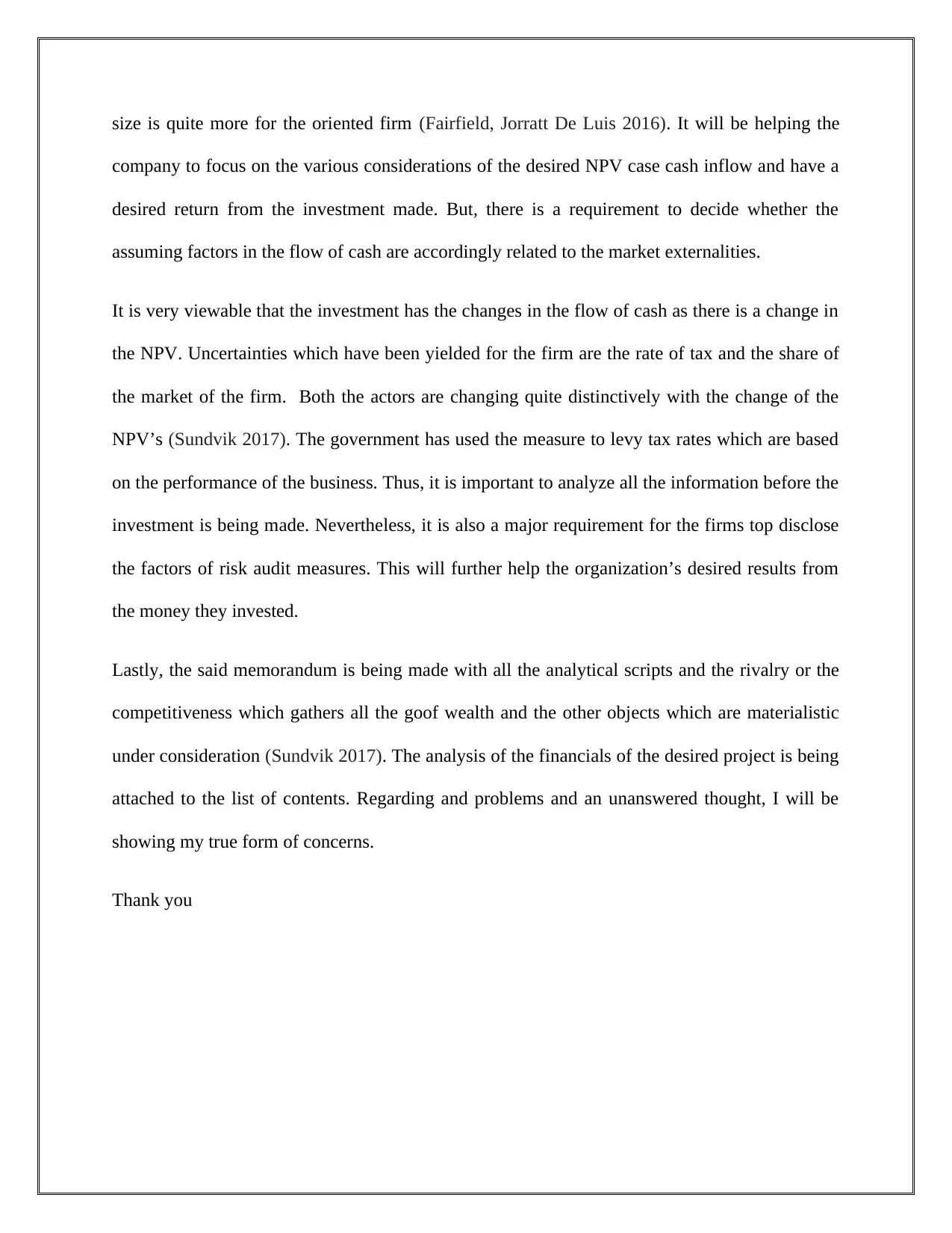
size is quite more for the oriented firm (Fairfield, Jorratt De Luis 2016). It will be helping the
company to focus on the various considerations of the desired NPV case cash inflow and have a
desired return from the investment made. But, there is a requirement to decide whether the
assuming factors in the flow of cash are accordingly related to the market externalities.
It is very viewable that the investment has the changes in the flow of cash as there is a change in
the NPV. Uncertainties which have been yielded for the firm are the rate of tax and the share of
the market of the firm. Both the actors are changing quite distinctively with the change of the
NPV’s (Sundvik 2017). The government has used the measure to levy tax rates which are based
on the performance of the business. Thus, it is important to analyze all the information before the
investment is being made. Nevertheless, it is also a major requirement for the firms top disclose
the factors of risk audit measures. This will further help the organization’s desired results from
the money they invested.
Lastly, the said memorandum is being made with all the analytical scripts and the rivalry or the
competitiveness which gathers all the goof wealth and the other objects which are materialistic
under consideration (Sundvik 2017). The analysis of the financials of the desired project is being
attached to the list of contents. Regarding and problems and an unanswered thought, I will be
showing my true form of concerns.
Thank you
company to focus on the various considerations of the desired NPV case cash inflow and have a
desired return from the investment made. But, there is a requirement to decide whether the
assuming factors in the flow of cash are accordingly related to the market externalities.
It is very viewable that the investment has the changes in the flow of cash as there is a change in
the NPV. Uncertainties which have been yielded for the firm are the rate of tax and the share of
the market of the firm. Both the actors are changing quite distinctively with the change of the
NPV’s (Sundvik 2017). The government has used the measure to levy tax rates which are based
on the performance of the business. Thus, it is important to analyze all the information before the
investment is being made. Nevertheless, it is also a major requirement for the firms top disclose
the factors of risk audit measures. This will further help the organization’s desired results from
the money they invested.
Lastly, the said memorandum is being made with all the analytical scripts and the rivalry or the
competitiveness which gathers all the goof wealth and the other objects which are materialistic
under consideration (Sundvik 2017). The analysis of the financials of the desired project is being
attached to the list of contents. Regarding and problems and an unanswered thought, I will be
showing my true form of concerns.
Thank you
Paraphrase This Document
Need a fresh take? Get an instant paraphrase of this document with our AI Paraphraser
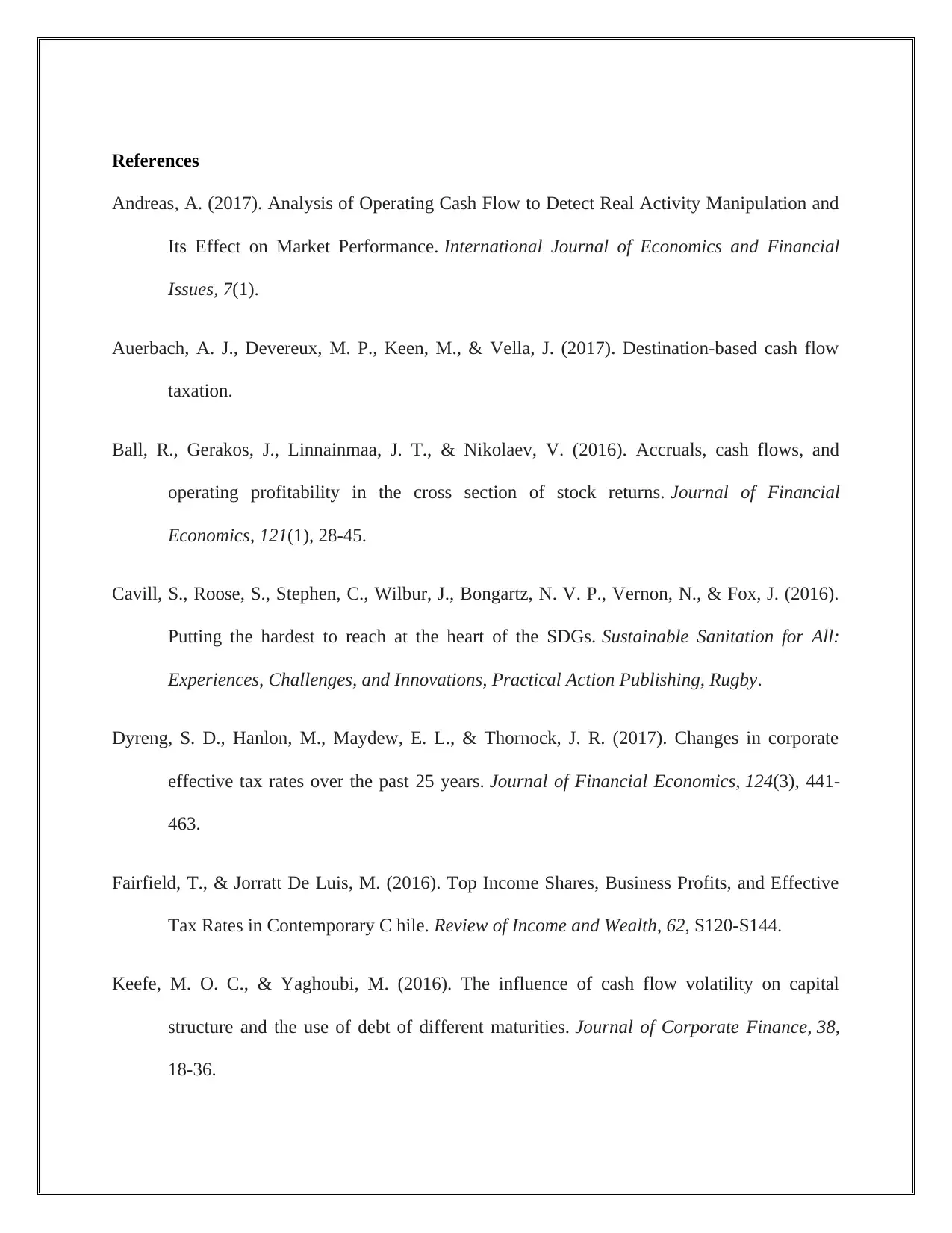
References
Andreas, A. (2017). Analysis of Operating Cash Flow to Detect Real Activity Manipulation and
Its Effect on Market Performance. International Journal of Economics and Financial
Issues, 7(1).
Auerbach, A. J., Devereux, M. P., Keen, M., & Vella, J. (2017). Destination-based cash flow
taxation.
Ball, R., Gerakos, J., Linnainmaa, J. T., & Nikolaev, V. (2016). Accruals, cash flows, and
operating profitability in the cross section of stock returns. Journal of Financial
Economics, 121(1), 28-45.
Cavill, S., Roose, S., Stephen, C., Wilbur, J., Bongartz, N. V. P., Vernon, N., & Fox, J. (2016).
Putting the hardest to reach at the heart of the SDGs. Sustainable Sanitation for All:
Experiences, Challenges, and Innovations, Practical Action Publishing, Rugby.
Dyreng, S. D., Hanlon, M., Maydew, E. L., & Thornock, J. R. (2017). Changes in corporate
effective tax rates over the past 25 years. Journal of Financial Economics, 124(3), 441-
463.
Fairfield, T., & Jorratt De Luis, M. (2016). Top Income Shares, Business Profits, and Effective
Tax Rates in Contemporary C hile. Review of Income and Wealth, 62, S120-S144.
Keefe, M. O. C., & Yaghoubi, M. (2016). The influence of cash flow volatility on capital
structure and the use of debt of different maturities. Journal of Corporate Finance, 38,
18-36.
Andreas, A. (2017). Analysis of Operating Cash Flow to Detect Real Activity Manipulation and
Its Effect on Market Performance. International Journal of Economics and Financial
Issues, 7(1).
Auerbach, A. J., Devereux, M. P., Keen, M., & Vella, J. (2017). Destination-based cash flow
taxation.
Ball, R., Gerakos, J., Linnainmaa, J. T., & Nikolaev, V. (2016). Accruals, cash flows, and
operating profitability in the cross section of stock returns. Journal of Financial
Economics, 121(1), 28-45.
Cavill, S., Roose, S., Stephen, C., Wilbur, J., Bongartz, N. V. P., Vernon, N., & Fox, J. (2016).
Putting the hardest to reach at the heart of the SDGs. Sustainable Sanitation for All:
Experiences, Challenges, and Innovations, Practical Action Publishing, Rugby.
Dyreng, S. D., Hanlon, M., Maydew, E. L., & Thornock, J. R. (2017). Changes in corporate
effective tax rates over the past 25 years. Journal of Financial Economics, 124(3), 441-
463.
Fairfield, T., & Jorratt De Luis, M. (2016). Top Income Shares, Business Profits, and Effective
Tax Rates in Contemporary C hile. Review of Income and Wealth, 62, S120-S144.
Keefe, M. O. C., & Yaghoubi, M. (2016). The influence of cash flow volatility on capital
structure and the use of debt of different maturities. Journal of Corporate Finance, 38,
18-36.
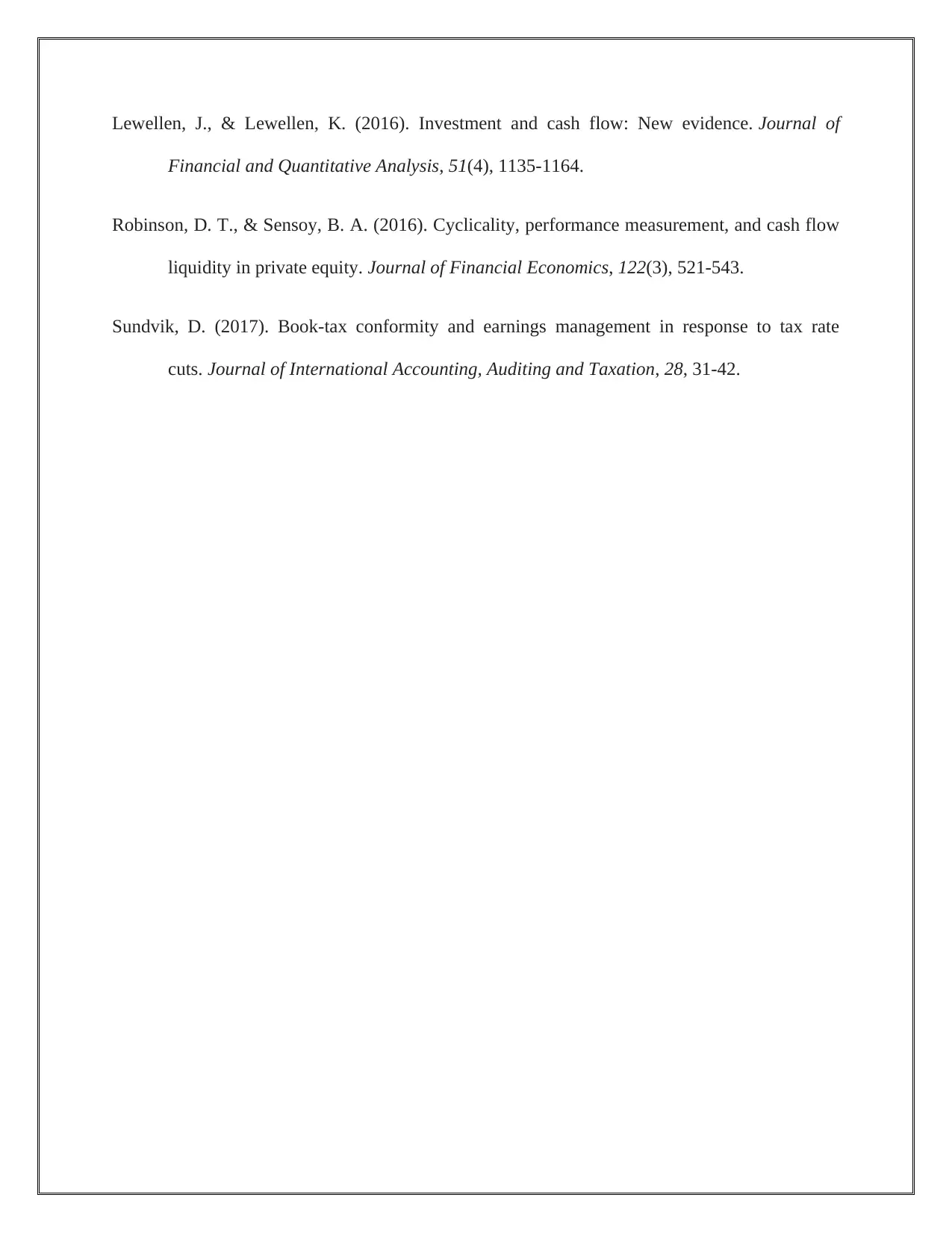
Lewellen, J., & Lewellen, K. (2016). Investment and cash flow: New evidence. Journal of
Financial and Quantitative Analysis, 51(4), 1135-1164.
Robinson, D. T., & Sensoy, B. A. (2016). Cyclicality, performance measurement, and cash flow
liquidity in private equity. Journal of Financial Economics, 122(3), 521-543.
Sundvik, D. (2017). Book-tax conformity and earnings management in response to tax rate
cuts. Journal of International Accounting, Auditing and Taxation, 28, 31-42.
Financial and Quantitative Analysis, 51(4), 1135-1164.
Robinson, D. T., & Sensoy, B. A. (2016). Cyclicality, performance measurement, and cash flow
liquidity in private equity. Journal of Financial Economics, 122(3), 521-543.
Sundvik, D. (2017). Book-tax conformity and earnings management in response to tax rate
cuts. Journal of International Accounting, Auditing and Taxation, 28, 31-42.
⊘ This is a preview!⊘
Do you want full access?
Subscribe today to unlock all pages.

Trusted by 1+ million students worldwide
1 out of 6
Related Documents
Your All-in-One AI-Powered Toolkit for Academic Success.
+13062052269
info@desklib.com
Available 24*7 on WhatsApp / Email
![[object Object]](/_next/static/media/star-bottom.7253800d.svg)
Unlock your academic potential
Copyright © 2020–2025 A2Z Services. All Rights Reserved. Developed and managed by ZUCOL.




